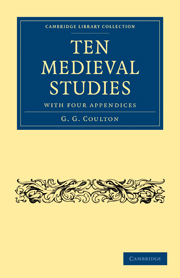Book contents
- Frontmatter
- PREFACE TO FIRST EDITION (1906)
- PREFACE TO SECOND EDITION (1915)
- PREFACE TO THIRD EDITION
- Contents
- I The Monastic Legend
- II A Revivalist of Six Centuries Ago
- III Side-Lights on the Franciscans
- IV The High Ancestry of Puritanism
- V Romanism and Morals
- VI The Truth about the Monasteries
- VII Religious Education before the Reformation
- VIII Priests and People before the Reformation
- IX The Failure of the Friars
- XIII The Plain Man's Religion in the Middle Ages
- Appendices
- Index
IX - The Failure of the Friars
Published online by Cambridge University Press: 07 September 2010
- Frontmatter
- PREFACE TO FIRST EDITION (1906)
- PREFACE TO SECOND EDITION (1915)
- PREFACE TO THIRD EDITION
- Contents
- I The Monastic Legend
- II A Revivalist of Six Centuries Ago
- III Side-Lights on the Franciscans
- IV The High Ancestry of Puritanism
- V Romanism and Morals
- VI The Truth about the Monasteries
- VII Religious Education before the Reformation
- VIII Priests and People before the Reformation
- IX The Failure of the Friars
- XIII The Plain Man's Religion in the Middle Ages
- Appendices
- Index
Summary
In preparing an edition for English readers of that strange autobiography which Brother Salimbene of Parma wrote for the edification of his niece (1221–88), I have often been embarrassed by the very wealth of my material. Those portions of the friar's story which are most significant for the study of thirteenth-century society are naturally just those which need, for the general reader, most explanation and illustration from other documents of the age. In many places, such full illustrations would have taken me too far afield, and I have been obliged to deal with them in separate essays. One of the most important of these subjects is the rapid decay of the Franciscan ideal—a subject often slurred over altogether, and never, so far as I am aware, thoroughly explained. The friars, however they may once have been misunderstood in an age of bitter strife, are now recognized on all hands as the greatest of all Church reformers during the first fifteen centuries. But, far beyond this just recognition, there is a growing tendency to make party capital by whitewashing the friars, in contrast to correspondingly blackened pictures of the sixteenth-century reformers. The former, it is argued, were the real saviours of the Church: the latter were mere bungling marplots. This theory, however, impinges on one serious difficulty, for, in spite of Francis and Dominic, the Church was at least as corrupt in 1500 as she had been in a.d. 1200. To meet this difficulty the “Great Pestilence” theory has been devised; and we are assured that Luther found the Church still reeling helplessly under the effects of the Plague of 1349.
- Type
- Chapter
- Information
- Ten Medieval Studieswith Four Appendices, pp. 166 - 188Publisher: Cambridge University PressPrint publication year: 2010First published in: 1930



